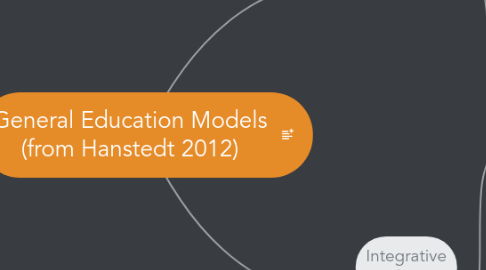
1. Distribution models
1.1. Objective: Create students who are "well-rounded" by taking courses representing major skills & areas of knowledge.
1.2. Types
1.2.1. Knowledge breadth
1.2.1.1. Arts & humanities
1.2.1.2. Mathematics
1.2.1.3. Natural sciences
1.2.1.4. Social sciences
1.2.1.5. Etc.
1.2.2. Skills breadth
1.2.2.1. Digital skills
1.2.2.2. Language
1.2.2.3. Physical education
1.2.2.4. Service
1.2.2.5. Etc.
1.3. Examples
1.3.1. LC
1.3.1.1. Current GE requirements
1.3.1.2. 2010-11 CAS GE models (Orion, Pegasus, etc.)
1.3.2. Elsewhere
1.3.2.1. Many!
2. Integrative models
2.1. Objective: Create students who can integrate (i.e., articulate connections between) major skills & areas of knowledge.
2.2. Types
2.2.1. Strands model: Thematic connections linking cross-divisional courses
2.2.2. Core-distributional model: First-year core to distribution to capstone
2.2.3. Core-only model: Sequence of required courses
2.3. Examples
2.3.1. LC
2.3.1.1. Current E&D requirements
2.3.1.2. 1985-1993 Basic/Critical/Advanced Inquiry sequence
2.3.2. Elsewhere
2.3.2.1. Integrative Liberal Learning initiative (Mellon-Teagle grant, 14 participating institutions)
2.3.2.2. Roanoke College: Intellectual Inquiry Curriculum
2.3.2.3. St. Joseph's College: Core Program
2.3.2.4. Wagner College: Distribution + experiential learning/learning communities
2.3.2.5. Worcester Polytechnic Institute: Project-based learning
